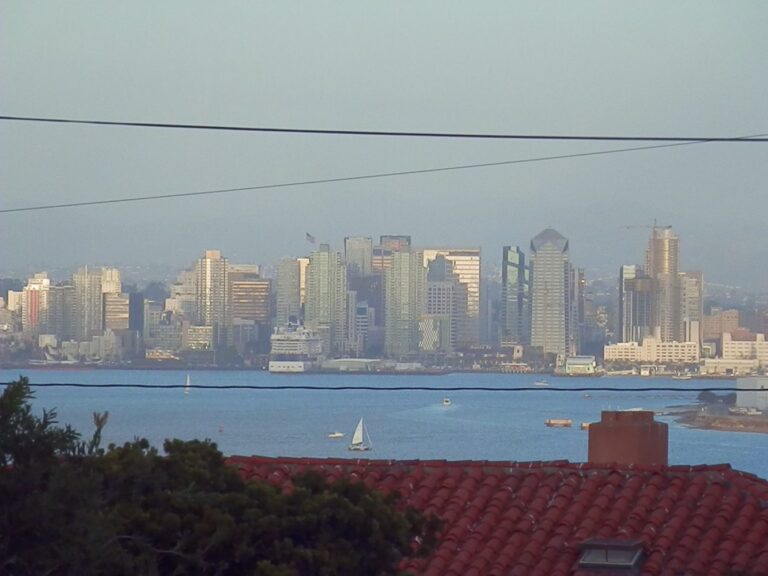Physical Address
304 North Cardinal St.
Dorchester Center, MA 02124
Physical Address
304 North Cardinal St.
Dorchester Center, MA 02124

My guest this week is Anthony Ling. Anthony is founder and editor of Caos Planejado, a Brazilian website on cities and urban planning. He also founded Bora, a transportation technology startup and is currently an MBA candidate at Stanford University. He graduated Architecture and Urban Planning at Universidade Federal do Rio Grande do Sul and worked with Isay Weinfeld early in his career. Read more about the ideas discussed in this week’s episode: Be sure to check out Caos Planejado. Whether Portuguese is your native language or you’re interested in Brazilian urban planning issues, it’s a fantastic resource. Learn more about the emergent order of informal favela development. Everyone interested in urban planning should, at the very lease, read the Wikipedia article on Brasilia. Learn more about on-demand transit. Help spread the word! If you are enjoying the podcast, please subscribe and rate us on your favorite podcasting platform. Find us on iTunes, PlayerFM, Pocket Casts, Stitcher, and Soundcloud. Our theme music is “Origami” by Graham Bole, hosted on the Free Music Archive.

Why are a growing number of libertarians fascinated by cities and indeed pinning their hopes for a freer future on cities? Two examples of this just from recent Freeman issues are by Zachary Caceres on startup cities and the winner of the Thorpe-Freeman Blog Contest, Adam Millsap, responding to one of the articles in an entire cities-themed issue. There is a deep affinity between cities and markets, and indeed between cities and liberty. (As the old saying goes, “City air makes you free.”) Cities aren’t merely convenient locations for markets; a living city (which I’ll define in a moment) is a market, and the first cities probably originated as markets. Much has been written on this connection, but I’d like to point out another link between cities and markets—one that comes from the great 20th century urbanist, Jane Jacobs. Consciously or not, Jacobs followed the tradition of the influential German sociologist Max Weber in seeing cities as essentially markets. Indeed, in her 1969 book The Economy of Cities, she defined a city, or what I like to call a “living city,” as “a settlement that consistently generates its economic growth from its own local economy.” Moreover, I’ve written elsewhere that today’s economic phenomena of demand, supply, the price system, markets, externalities, public goods, and division of labor had their genesis in an urban setting. The fundamental (classical) liberal concepts of property rights, economic freedom, and the rule of law did not develop among wandering nomads, farmers, or in small villages but perforce from the interactions of strangers with diverse cultures and backgrounds interacting in dense proximity with one another. Diversity… In her great book of 1961, The Death and Life of Great American Cities, Jacobs first presented her argument that the key feature of any great city is its diversity. […]

1. This week at Market Urbanism: 4 Things Austin’s City Council Could Do Today To Fight The Housing Shortage by Dan Keshet Central Austin needs more housing. Prices have been rising, more and more people want to live where they have short commutes, but are only able to afford homes near the periphery. We have a long-term plan to alter our land development code in a way that would help…but our need is now. What options are available today? Spillovers: Knowledge, Beer, and Technology by Sandy Ikeda I don’t think anyone could reasonably contest that technology has reduced the need for some kinds of proximity. It’s the tired hyperbole that “science obliterates distance” and the like that gets my goat. The gulf between “reducing” and “eliminating” is too vast. Where Do Upzonings Happen? by Chris Bradford What NIMBYs are really after is limiting access to neighborhood amenities, mostly by limiting the quantity of housing. Neighborhoods (at least the ones empowered politically) do their best to hold housing below the market-clearing quantity. Book Review: The Well-Tempered City by Emily Hamilton a review of a book by Jonathan F. P. Rose In the vein of Jane Jacobs and F.A. Hayek, Rose identifies that cities are “wicked” problems rather than engineering problems that policymakers can solve through tinkering. In spite of this recognition of the complexity of cities’ interrelated systems, Rose asserts that cities need visionaries to address problems from obesity to climate change from the top down. 2. Where’s Scott? Scott Beyer has changed his schedule. He thought San Diego would be a pass-through stop this week on the way to Los Angeles. But he found “America’s Finest City” surprisingly dense, and decided to stay all of October. His two Forbes articles this week were about The Millennials Transforming San Antonio and […]

This book review is part of a TLC Book Tour. The Well-Tempered City: What Modern Science, Ancient Civilizations, and Human Nature Teach Us About the Future of Urban Life by Jonathan F. P. Rose In The Well-Tempered City, real estate developer Jonathan F. P. Rose offers a sweeping history of cities and equally grandiose policy proposals to improve urban outcomes. In the vein of Jane Jacobs and F.A. Hayek, Rose identifies that cities are “wicked” problems rather than engineering problems that policymakers can solve through tinkering. In spite of this recognition of the complexity of cities’ interrelated systems, Rose asserts that cities need visionaries to address problems from obesity to climate change from the top down. Rose leads with the most interesting section of his book on the origins of early cities. In support of his theory that great cities are built by visionaries, he focuses on ancient cities that were founded around religious sites, including Uruk and Teotihuacan, downplaying the path of great cities emerged organically from trading posts, like Venice or Rotterdam. He advocates for the benefits of orderly urban layouts like Hippodamian plan or the magic square that ancient Chinese cities followed. A theme running throughout the book is that American urban planning has embraced the Western values of individualism and free will while giving short shrift to the Eastern value of harmony, such as the unification that comes from top-down urban design. In support of more cohesive plans, Rose downplays the incredible progress that has been possible through decentralized urban and economic development. Throughout the book, Rose argues that American cities are suffering from a lack of vision from their planners. Unlike ancient leaders who built grand temples and imposing walls, today’s planners focus on enforcing rules rather than defining a city’s aesthetics. He writes: It turns out that a city can pick any […]

I think the most useful way to think about NIMBYism is as a neighborhood-centered phenomenon. When people shop for homes, they shop for specific, physical features of a dwelling, of course, but mainly they shop for neighborhoods. The quality of neighborhood amenities — interpreted broadly to include things like school quality and access to the CBD — varies wildly from neighborhood to neighborhood, and thus does the amount people are willing to pay for those amenities. What NIMBYs are really after is limiting access to neighborhood amenities, mostly by limiting the quantity of housing. Neighborhoods (at least the ones empowered politically) do their best to hold housing below the market-clearing quantity. This ensures that the value of neighborhood amenities is capitalized into home prices. Without quantity controls, the “nicest” neighborhoods would be the densest. Instead, thanks to zoning, they’re simply the most expensive. There’s a steep premium for buying into the neighborhood club. Here’s evidence in favor of the “club” theory from L.A. planner C.J. Gabbe. (H/t Urbanize.LA.) Gabbe asks the question, “Where do upzonings and downzonings happen?” To answer it, he looked at how the zoning of each of L.A.’s 780,000 parcels changed between 2002 and 2014, and tallied whether a lot was “upzoned” or “downzoned”, as measured by the change in allowed residential density. The first striking result was how few of the parcels were either upzoned or downzoned: an average of just 225 acres were upzoned and 216 acres downzoned annually between 2002 and 2014. That is, less than two-tenths of one percent of L.A.’s land area was upzoned or downzoned each year. Given the surge in demand for housing in L.A., especially over the last 6 years or so, that’s remarkably little. But the other thing Gabbe documents is that resistance to zoning really does seem to […]

In my last article, I wrote about how an economically and culturally vital city is able, without central planning, to generate two things that are essential to the city’s success: diversity and cohesion. I argued that when lots of people who reflect a huge range of skills and tastes can live together peacefully (diversity) and when they feel free to associate to any degree they choose (cohesion), the result tends to be rich, complex, and dynamic social networks that channel information from person to person rapidly and effectively. For many who hear this argument, however, how this happens remains a mystery. And I don’t blame them for feeling that way. Some urban economists and urban sociologists explain this in terms of “knowledge spillovers.” Proximity enables people who are socially distant to mingle and exchange ideas; the image of chance meetings and chatting up over coffee or a beer comes to mind. Sometimes it does happen that way. Many of the innovators in Silicon Valley in the 1960s, for example, informally traded ideas at the famed Wagon Wheel bar. The term “spillover” evokes this informality over the occasional sloshed mug of beer (or sloshed patron). Social Media: Complement or Substitute? I listened to an interview recently with urban economist Edward Glaeser of Harvard University on Russ Roberts’ podcast, Econtalk. The main topic was the recent declaration of bankruptcy by the Detroit city government, but the discussion also touched on more basic issues such as why people still need to live in cities. Some of my colleagues argue, for example, that face-to-face interactions are becoming obsolete with technical advances such as Facebook, Skype, and email. Back in the early twentieth century, as the telephone spread to more and more homes, pundits at the time—among them the architect Frank Lloyd Wright—claimed that science would “obliterate distance” […]

Central Austin needs more housing. Prices have been rising, more and more people want to live where they have short commutes, but are only able to afford homes near the periphery. We have a long-term plan to alter our land development code in a way that would help…but our need is now. What options are available today? END PARKING REQUIREMENTS IN WEST CAMPUS Every year, West Campus adds more and more dense student housing, and, along with it, pedestrian amenities like wide sidewalks and street trees. A parking benefit district meters on-street parking with proceeds plowed back into neighborhood improvements. Surveys have shown the vast majority of West Campus students get around without cars. Allowing housing for students without parking could allow denser housing, lower construction costs, or allow more creative buildings that take advantage of unique lots. Removing minimum parking rules has already resulted in a few buildings downtown targeting markets that either don’t need cars or have other places to park them; this could be even more true in student-rich West Campus. REDUCE PARKING REQUIREMENTS NEAR TRANSIT ROUTES The same logic of reducing parking requirements applies outside the student market to apartments near transit routes. More and more people in Austin want to live car-free or car-light. That is easiest to do in buildings created with that lifestyle in mind–a step that can both reduce construction costs and allow room for improving other amenities. Long-term, if Austin wants to be a sustainable city, parking-free typologies should be allowed everywhere. However, in much of Austin, we wrongly treat scarce on-street parking as an endless “commons” rather than managing it as a scarce resource. This means that it may be wiser to improve incrementally–reducing off-street parking requirements, improving on-street parking management, and improving transportation options. IMPLEMENT THE DOWNTOWN AUSTIN PLAN New high-rise towers are being constructed in downtown Austin all the time–but downtown is more than just the Central Business District. […]

1. This week at Market Urbanism: Joel Kotkin’s New Book Lays Out His Sprawling Vision For America by Michael Lewyn So if I interpret his book correctly, it seems that there is nothing libertarian about Kotkin’s views: he wants strong local governments that keep new housing out of cities but allows it in undeveloped exurbs where it belongs. NIMBYism As An Argument Against Urbanism by Michael Lewyn [Kotkin] cites numerous examples of NIMBYism in wealthy city neighborhoods, and suggests that these examples rebut “the largely unsupported notion that ever more people want to move ‘back to the city’.” This argument is nonsense for two reasons. The Demand Curve For Sprawl Slopes Downward by Sandy Ikeda There has been a lot of Internet chatter lately about what libertarians ought to think about urban sprawl and its causes, including pieces by Kevin Carson, Austin Bramwell, Randal O’Toole, and Matthew Yglesias. The title of Ben Adler’s post basically sums it up: “If You Love the Free Market, You Should Hate Mandated Suburban Sprawl.” Econ 101 And The Missing Middle by Chris Bradford Some cities build more single-family than multi-family. Some build more multi-family than single-family. But the fourplex is dead. We build very little small-scale multi-family these days, which is why the “missing middle” is a focus of zoning code rewrites and a meme among the New Urbanist crowd. You’re an Urbanist? Excellent. Why Aren’t You a Developer Yet? by R John Anderson This question becomes a bit more pointed when you recognize that many conventional developers are doing work in urban settings under duress or without much of a clue about how to make their efforts fit an urban context. I think the typical generalist/urbanist will do a better job than whatever big development outfits are working in their city. 2. […]
I continue to ask urbanists “why aren’t you a developer yet?” That’s a sincere and serious question. I want to recruit architects, planners, engineers and activists who consider themselves urbanists (new or otherwise) into the ranks of the small developer cohort, because I think it is the best way for urbanists to have an impact on places they care about. If you have devoted thousand of hours of study and practice to what makes a good place, why leave the construction and renovation of buildings to developers? This question becomes a bit more pointed when you recognize that many conventional developers are doing work in urban settings under duress or without much of a clue about how to make their efforts fit an urban context. I think the typical generalist/urbanist will do a better job than whatever big development outfits are working in their city. While urbanists are working to heal the city or build better places, they should hang onto some of the buildings that get built/rebuilt along the way. Having a modest portfolio of buildings that pay rent will help them weather the next recession. (It is really hard to make a living doing fee for service or consulting work when nothing is getting built). With those reasons in mind, we still need to have a sober and realistic grasp of what is involved for someone to become a developer, given the arena they will likely operate in. This stuff ain’t easy. People tend to think that all real estate developers make tons of money, because some developers have. For every major league star in the real estate game there are scores of people hustling to make a living by making their neighborhood better. I don’t know how people arrive at the amount of money they assume is made on […]

Also read my other post about Kotkin’s book: NIMBYism as an Argument Against Urbanism Traditionally, defenders of suburban sprawl have been skittish about proclaiming that government should promote sprawl and halt infill development. Instead, they have taken a libertarian tack, arguing that government should allow any kind of development while asserting that a level playing field would favor automobile-dependent suburbia. But in his new book The Human City, Joel Kotkin, who, among many other titles, is the executive director of a pro-sprawl organization called the Center for Opportunity Urbanism, appears to take a different view. Like more libertarian defenders of the status quo, he generally opposes attempts to limit new suburban development. But he also writes that both city residents and suburbanites aggressively resist “densification”- that is, when nearby landowners want to build new housing or offices. For example, he writes that Los Angeles neighborhood activists “have rallied against attempts to build denser buildings, which generate more congestion and erode both the area’s livability and its distinct urban identity.” Similarly, he writes that some New Yorkers opposed “Mayor Bloomberg’s attempts to further densify already congested Midtown.” But Kotkin never suggests that turning a cornfield into a subdivision creates congestion, or that doing so would erode an area’s “distinct rural identity.” He also doesn’t seem to think that new housing belongs in existing suburbs: in describing zoning that prohibits such housing, he writes that “suburbs generally can be expected to, for the most part, resist high degrees of densification”, including “attempts by planners to impose strict regulations on construction and impose higher densities”. This language implies (erroneously) that “densification” is something imposed by a distant government, rather than by landowners who want to build places for people to live. So if I interpret his book correctly, it seems that there is nothing libertarian […]